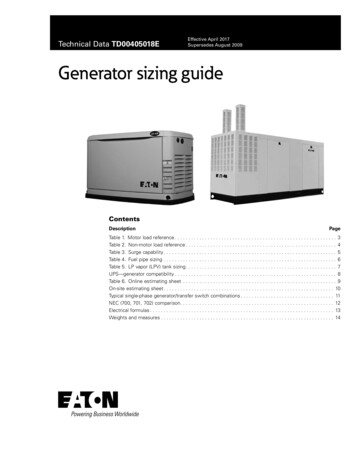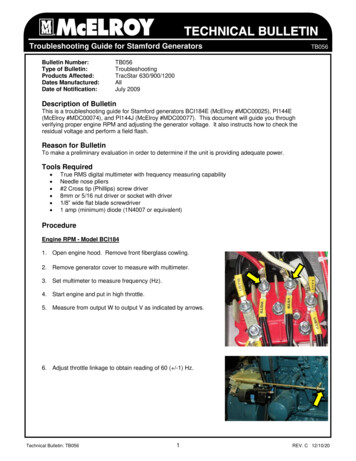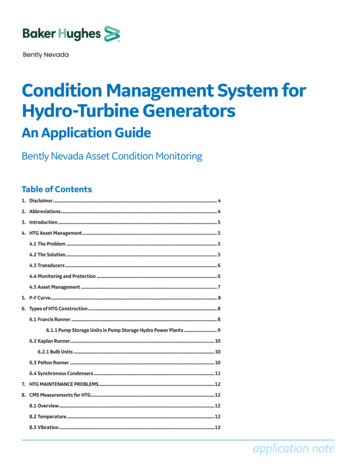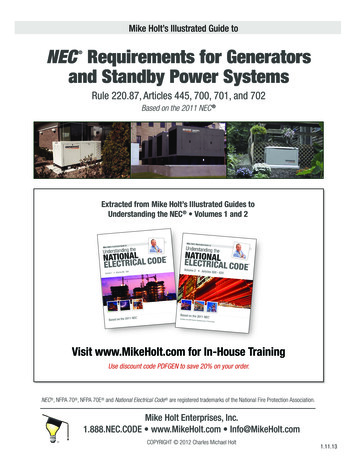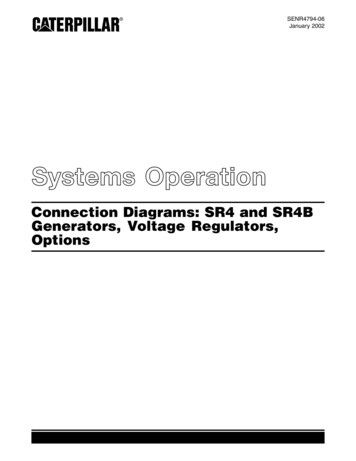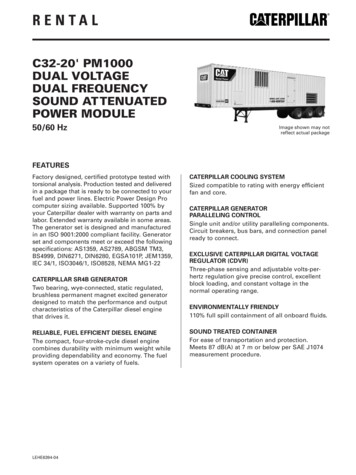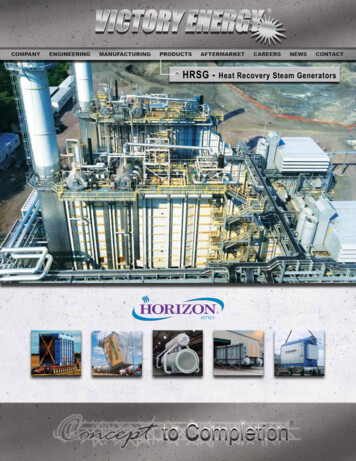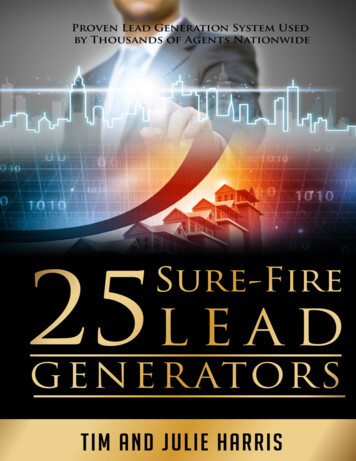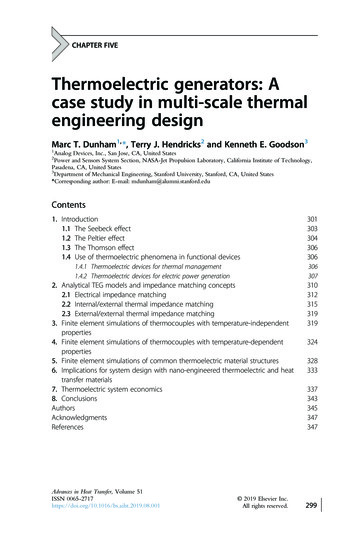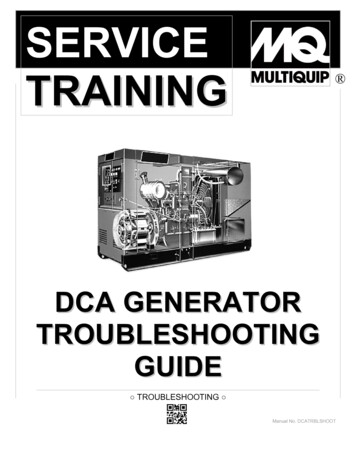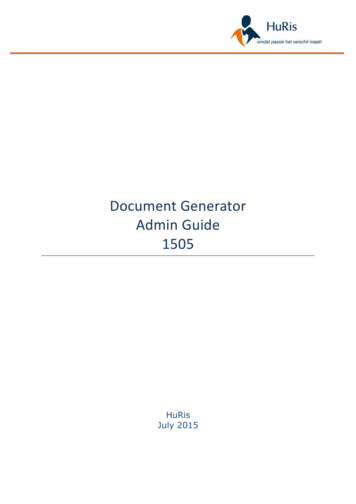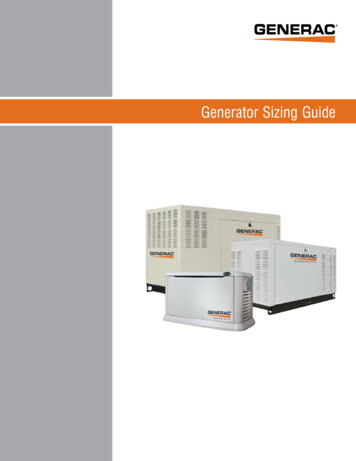
Transcription
Generator Sizing Guide
IMPORTANT NOTICE:This booklet is designed to familiarize estimators and installers with proper sizing guidelines for residentialand commercial generators. The information is not comprehensive, nor does it replace or supercedeany material contained in any of the written documents shipped with the equipment. This booklet shouldonly be used in conjunction with the Owner’s Manual, Installation Manual and other technical documentsshipped with each product. Always read all accompanying documentation carefully before attempting toinstall any generator, transfer switch or related equipment.HOW TO USE THIS BOOKLET:Within this booklet, you will find electrical load information, plus an outline of generator surge capability, fuel pipesizing, liquid propane tank sizing, and UPS / generator compatibility. The worksheet pages can be removedfrom the book and photocopied to create additional Onsite Estimating Sheets for use with individual jobs.SAFETY INFORMATION:Proper sizing of the generator is crucial to the success of any installation and requires a good workingknowledge of electricity and its characteristics, as well as the varying requirements of the electrical equipmentcomprising the load. When analyzing the electrical load, consult the manufacturer’s nameplate on eachmajor appliance or piece of equipment to determine its starting and running requirements in terms of watts,amps and voltage. When choosing the generator output for commercial or industrial applications, selecta rating that is approximately 20 to 25% higher than the peak load (for example, if the load is about 40kilowatts, select a 50 kW genset). A higher rated generator will operate comfortably at approximately 80%of its full capacity and will provide a margin of flexibility if the load increases in the future.For safety reasons, Generac recommends that the backup power system be installed, serviced andrepaired by a Generac Authorized Service Dealer or a competent, qualified electrician or installationtechnician who is familiar with applicable codes, standards and regulations.It is essential to comply with all regulations established by the Occupational Safety & Health Administration(OSHA) and strict adherence to all local, state and national codes is mandatory. Before selecting a generator,check for municipal ordinances that may dictate requirements regarding placement of the unit (setbackfrom building and/or lot line), electrical wiring, gas piping, fuel storage (for liquid propane or diesel tanks),sound and exhaust emissions.
Generator Siz ing guideTable of ContentsTable 1 – Motor Load Reference . . . . . . . . . . . . . . . . . . . . . . . . . . . . . . . . . . . . . . . . . . . . . . . . . . 5Table 2 – Non-Motor Load Reference . . . . . . . . . . . . . . . . . . . . . . . . . . . . . . . . . . . . . . . . . . . . . . 6Table 3 – Surge Capability . . . . . . . . . . . . . . . . . . . . . . . . . . . . . . . . . . . . . . . . . . . . . . . . . . . . . . . 7Table 4 – Fuel Pipe Sizing . . . . . . . . . . . . . . . . . . . . . . . . . . . . . . . . . . . . . . . . . . . . . . . . . . . . . . . 8Table 5 – LP Vapor (LPV) Tank Sizing . . . . . . . . . . . . . . . . . . . . . . . . . . . . . . . . . . . . . . . . . . . . . . 9UPS – Generator Compatibility . . . . . . . . . . . . . . . . . . . . . . . . . . . . . . . . . . . . . . . 10Typical Generator/Transfer Switch Combinations . . . . . . . . . . . . . . . . . . . . . . . . . . . . . . . . . . . 11NEC 700, 701, 702 Comparison . . . . . . . . . . . . . . . . . . . . . . . . . . . . . . . . . . . . . . . . . . . . . . . . . . 12Electrical Formulas, Weights and Measures . . . . . . . . . . . . . . . . . . . . . . . . . . . . . . . . . . . . . 13, 14Onsite Estimating Sheet . . . . . . . . . . . . . . . . . . . . . . . . . . . . . . . . . . . . . . . . 15-16System Capacity – Load Calculator . . . . . . . . . . . . . . . . . . . . . . . . . . . . . . . . 17-183
Generator Si zing gui d eNotes4
Generator Siz ing guideCaution:DO NOT size the generator based on starting kW alone.YOU MUST compare LR Amps to generator surge capability (table #3).SIZE the generator by following the sizing instructions.motor load referenceTable 1AC & Heat PumpsRunning LoadStarting LoadStartingkWDescriptionHpRunningkWAmps @240V 1ØAmps @208V 3ØAmps @240V 3ØAmps @480V 3ØLR Amps @240V 1ØLR Amps @208V 3ØLR Amps @240V 3ØLR Amps@ 480V 3Ø1 Ton(12,000 BTU)115331332219102.52 Ton(24,000 BTU)22107636744381953 Ton(36,000 BTU)331510841006758297.54 Ton(48,000 BTU)442013116117786734105 Ton(60,000 BTU)55251614714597844212.57.5 Ton(85,000 BTU)7.57.537242111219146126631710 Ton*(120,000 BTU)5 Hp (x2)104933281414597844212.510 Ton(120,000 BTU)10 Hp1049332814250167144722015 Ton*(180,000 BTU)7.5 Hp (x2)1574494221219146126631715 Ton(180,000 BTU)15 Hp15744942213752502171083020 Ton*(240,000 BTU)10 Hp (x2)2098655728250167144722020 Ton(240,000 BTU)20 Hp20n/a6557285003332891444025 Ton(300,000 BTU)2525n/a8271356254163611805030 Ton*(360,000 BTU)15 Hp (x2)30n/a9885423752502171083030 Ton(360,000 BTU)30 Hp30n/a9885427505004332176040 Ton*(480,000 BTU)20 Hp (x2)40n/a131113575003332891444040 Ton(480,000 BTU)40 Hp40n/a1311135710006665772898050 Ton*(480,000 BTU)25 Hp (x2)50n/a163142716254163611805050 Ton(480,000 BTU)50 Hp50n/a163142711250833722361100* For Multiple motor configurations, sequence starting is assumed.General ResidentialAir Conditioning1 hp per 1 ton1 ton 12,000 BTUsRunning LoadStarting LoadDescriptionHpRunning kWAmps @120V 1Ø4.9Amps @240V 1ØStarting kWLR Amps @120V 1ØLR Amps @240V 1ØRefrigerator pump,sump, furnace,garage opener0.50.54.92.51.52513Freezer, washer,septic grinder0.750.757.43.72.33819General 1 Hp119.84.935025Well & septiclift pump2219.69.86100505
Generator Si zing gui d eTable 2NON-MOTOR LOAD REFERENCEResidentialRunning Load*DescriptionElectric heat per 1000 ft2Heat pump elements per 1000 ft2kWAmps at120V 1øAmps at240V 1ø12n/a507n/a29Dryer5.5n/a23Hot tub10n/a50Range oven/Stove top per burner8n/a304.5n/a19324.9n/aBlow /aToasters18.3n/aHome Entertainment ry1.512.5n/aHot waterGeneral lighting and receptaclesper 1000 ft2*Always check data plate for actual running amps.CommercialPlease refer to equipment data plate and/or billing history for commercial details.6
Generator Siz ing guidesurge capabilityTable 3Generac Generators (Operating at less than 3600 RPM)Rated Output(Running Amps)Commercial Surge Capability(LR Amps @ 15% Voltage Dip)Residential Surge Capability(LR Amps @ 30% Voltage Dip)Size (kW)240V 1Ø208V 3Ø240V 3Ø480V 3Ø240V 1Ø208V 3Ø240V 3Ø480V 3Ø240V 1Ø208V 3Ø240V 3Ø480V 9Generac Generators (Operating at 3600 RPM)Rated Output(Running Amps)Commercial Surge Capability(LR Amps @ 15% Voltage Dip)Residential Surge Capability(LR Amps @ 30% Voltage Dip)Size (kW)240V 1Ø208V 3Ø240V 3Ø480V 3Ø240V 1Ø208V 3Ø240V 3Ø480V 3Ø240V 1Ø208V 3Ø240V 3Ø480V 7431Note: All nominal ratings based upon LP fuel. Refer to specification sheet forNG ratings and deration adjustments for ambient temperature and altitude.7
Generator Si zing gui d eTable 4fuel Pipe sizingNatural Gas (Table values are maximum pipe run in 245190130115958560352515Pipe Size 8556039022519514050303"LPLPG: 8.55 ft 3/lb., 4.24 lbs./gal., 2500 btu/ft3LPG: 36.3 ft3 1 gal.1185710630460215150Natural Gas1 cubic foot 1,000 BTU1 therm 100,000 BTUGas consumption 13,000-16,000 BTU per kW/hrPressure1 inch mercury 13.61 inches water column1 inch Water Column 0.036 psi5-14 inches water column 0.18 psi to 0.50 psiLP Vapor (LPV) (Table values are maximum pipe run in feet.)kW7-81012-1415 40480365275260195125107827070452015Pipe Size 1305660490Note:– Pipe sizing is based on 0.5" H2O pressure drop.– S izing includes a nominal numberof elbows and tees.– Please verify adequate service and meter sizing.
Generator Siz ing guideLP VApor (lpV) tank sizingTable 5Vapor WithdrawalTank CapacityTotal (Gal.)Tank CapacityUseable (Gal.)Minimum Temp( Overall 472,3201924150Load (kW)BTU / HrLP Gal / HrNG Ft3 / 01,170,00012.71,15411.5NG Therms/ 4,100,00045.34,10049.0Operating Cost Per Hour NG Therms/HR x Cost of NG ThermTank Capacity (btu/hr.)Gas Required For Common AppliancesApplianceApproxlmateInput BTU / HrWarm Air FurnaceSingle FamilyMultifamily, per unit100,00060,000Hydronic Boiler, Space HeatingSingle FamilyMultifamily, per unit100,00060,000Hydronic Boiler, Space and Water HeatingSingle FamilyMultifamily, per unit120,00075,000Range, Free Standing, DomesticBuilt-In Oven or Broiler Unit, DomesticBuilt-ln Top Unit, Domestic65,00025,00040,000Water Heater, Automatic Storage, 30 to 40 gal. TankWater Heater, Automatic Storage, 50 gal. TankWater Healer, Automatic Storage, Instantaneous2 GPM4 GPM6 GPMWater Heater, Domestic, Circulating or Side-Arm35,00050,000RefrigeratorClothes Dryer, Type 1 (Domestic)Gas Fireplace Direct VentGas logBarbecueGas lightIncinerator, 0080,00040,0002,50035,000Table Reprinted From Table 5.4.2.1, NFPA 54, 2002 ed.Note: Tank BTU capacity and generator run times based upon maintaininga minimum tank fuel level of 20%. Tanks are typically filled to 80% full.Note: Typical fuel consumption based on a generator 100% loaded.9
Generator Si zing gui d eUPS - GENERATOR COMPATIBILITYPassive (also referenced as standby or off-line) and Line-InteractiveThese technologies are most common for personal workstations and point of sale applications. They are typically single phase equipmentwith size ranges of 350 VA - 2000 VA for passive and 500 VA to 5000 VA for line-interactive.Passive UPS’s are the simplest type. Under normal conditions AC power passes straight through to the UPS load. When the input powersupply goes outside of specifications, the UPS transfers the load from input power to the internal DC to AC power inverter. Passive UPS’s donot correct for voltage or frequency deviations under “normal” operation.Line-interactive is similar to the passive technology except it has circuitry that attempts to correct for standard voltage deviations. Frequencydeviations under “normal” power operation are not corrected.Equipment Notes:These devices tend to be electrically / harmonically very noisy. A single small UPS is not a significant concern,but applications with multiple UPS’s can be problematic.Passive UPS technology typically has normal tolerances of 10-25% on voltage and 3 hertz on frequency. Minuteman UPSinput tolerance is closer to 10-36%. If the input source goes outside of these tolerances, the UPS will switch onto the UPSbattery source. Some line-interactive units may have frequency tolerances factory set to 0.5 hertz. These units will needto have their frequency tolerance increased to a minimum of 2 hertz. Minuteman UPS products are close to 5 hertz andnot 0.5 hertz.Generator Sizing Recommendation:Limit the total UPS loading to 15% - 20% of the generator capacity.Double-ConversionThis technology is most common for critical load applications. Double-conversion UPS’s constantly rectify AC to DC and then invert the DCback into AC. This configuration results in an output that corrects for voltage and frequency deviations.There are single and three phase models covering small through large applications. Most UPS applications larger than 5000 VA use doubleconversion technology. This approach is also the preferred technology for generator applications.Equipment Notes:Double-conversion UPS’s that are single phase or unfiltered three phase models tend to create a significant level ofelectrical/ harmonic noise. This is illustrated by harmonic
– Pipe sizing is based on 0.5" H2O pressure drop. – Sizing includes a nominal number of elbows and tees. – Please verify adequate service and meter sizing. Natural Gas (Table values are maximum pipe run in feet .) LP Vapor (LPV) (Table values are maximum pipe run in feet .) LP LPG: 8.55 ft 3/lb., 4.24 lbs./gal., 2500 btu/ft3 LPG: 36.3 ft3 .
